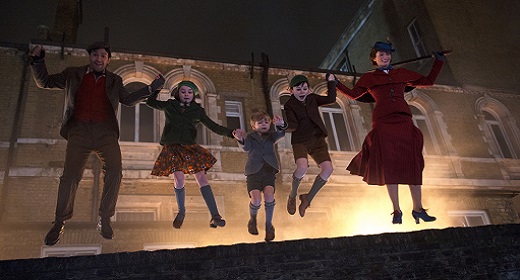by Stephanie Fairyington: The highly-anticipated sequel starring Emily Blunt and Lin-Manuel Miranda reminds us to never lose sight of wonder…
Emily Blunt and Lin-Manuel Miranda soar, literally, in the cinematic gem Mary Poppins Returns, which surprisingly rivals the 1964 original starring the incomparable Julie Andrews. This version of the story begins in 1930s London in the Banks’ family’s crumbling estate, where Mary Poppins’s original charges, Jane and Michael (now grown), as well as Michael’s three children, reside. Minutes into the film, we hear a harsh rapt at the door. It’s two bank lackeys, declaring the iconic home on 17 Cherry Tree Lane in danger of repossession if Michael can’t pay back a loan on which he’s defaulted.
In a state of mourning after the passing of his wife — and mother of his 3 kids, Georgie, John and Annabel — Michael is incapable of maintaining their home and financial affairs. In order to keep their residence, the family must find a certificate proving that Michael’s father’s ample shares in the bank, where Michael works, should pay his debt.
Tearing up the attic to find the missing document, Michael discovers an old kite from his youth that evokes a fond memory in his sister Jane. She asks, “Remember that day?” But his despair and hopelessness compel him to shove the kite — a symbol of his childhood awe, wonder and optimism — into a box for the dustbin. Georgie, his youngest child, eventually finds the discarded kite and sends it up to the heavens, which beckons the great Mary Poppins from the sky.
Michael and Jane, so removed from their younger selves, no longer believe the magic she manifested in their childhoods. Even the kids are suspicious, but not for long. Soon, the children, as well as we, the audience, are swept up into a world that delightfully defies logic and makes us believe in the impossible.
While the film is rife with positive takeaways on how to weather hard times, it’s fundamentally about the awe and power of the inexplicable in our actual lives — the dream that manifested in real life; the uncanny awareness of having already been somewhere you’ve just arrived for the first time; the impossible coincidence that leaves a trail of goosebumps up your arm; and the overwhelming sensation that overcomes you when you look up at a starry night and realize the mystery and vastness of the sky. Here, Mary Poppins seems to say, beneath the monotony of your daily grind, is the life that awaits if you just believe.
Throughout the movie she repeatedly asks us to suspend disbelief and feel the force that lies beyond logic. She sings one song (“Can You Imagine That?”) to urge the young children into the bath, where she promises they’ll discover a rich underworld. They don’t buy it at first, but after a bit of convincing, the three, along with Poppins herself, dive into a shiny clawfoot tub, where they end up in an ocean full of enchanting sea creatures, abandoned old ships and pirates still searching for treasure.
Another poignant scene takes the quartet into an illustration on a favorite bowl of their late mother, where Poppins tells the kids: “We’re on the brink of an adventure, children! Don’t spoil it with too many questions.” Poppins is wonder untethered from the need to interrogate and understand. She’s represents faith in the unknown and unknowable.
Science proves we have a lot to gain by seeking out awe and wonder in our everyday lives — it cultivates a desire to share, collaborate, and help each other, perhaps reminding us of the miracle that set us spinning around this wondrous universe together.
A leading scholar of awe, Dacher Keltner, Ph.D., a professor in the department of psychology at U.C. Berkeley, whose research points out how awe can transform our lives, begins one of his seminal papers on the topic with a quote from Albert Einstein: “The most beautiful emotion we can experience is the mysterious. It is the power of all true art and science. He to whom this emotion is a stranger, who can no longer pause to wonder and stand rapt in awe, is as good as dead.”
Or, as the original Mary Poppins put it in her nonsensically poignant and succinct way: don’t forget to tap into the “Supercalifragilisticexpialidocious.”





















































